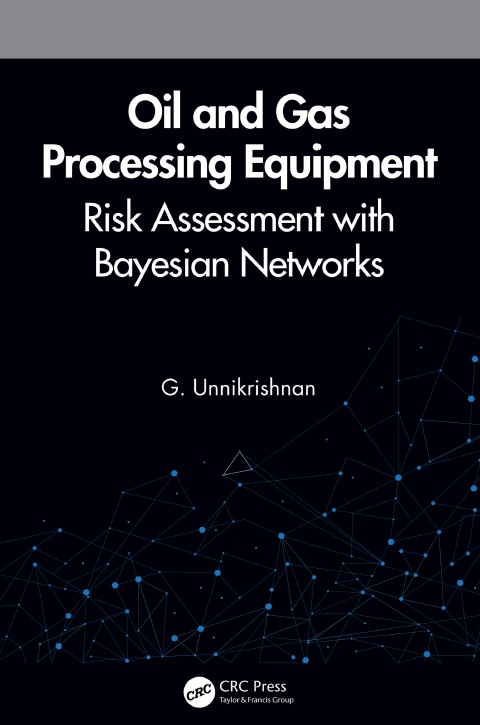By G. Unnikrishnan

Contents
Preface ……………………………………………………………………………………………………….xi
Author ……………………………………………………………………………………………………. xiii
1. Introduction ………………………………………………………………………………………..1
1.1 Application of BNs for Risk Assessment …………………………………….1
1.2 The Readership …………………………………………………………………………..2
1.3 Major Limitations of QRA ………………………………………………………….2
1.4 BN and Its Advantages ……………………………………………………………….3
1.5 Scope of the Book ……………………………………………………………………….4
1.6 Structure of the Book ………………………………………………………………….5 2. Bayes Theorem, Causality and Building Blocks for Bayesian Networks ……………………………………………………………………………..7 2.1 Probability Basics ……………………………………………………………………….7 2.1.1 Law of Total Probability ……………………………………………….. 10 2.1.2 Bayes Formula for Conditional Probability ………………….. 11 2.2 Bayes Theorem and Nature of Causality ………………………………….. 13 2.3 Bayesian Network (BN) ……………………………………………………………. 14 2.3.1 General Expression for Full Joint Probability Distribution of a BN 15 2.3.2 Illustrative Example of Application ……………………………… 15 2.4 Oil and Gas Separator ……………………………………………………………… 18 2.5 Sensitivity to Findings ………………………………………………………………22 2.6 Use of Probability Density Functions and Discretization ………… 24 2.7 Framework for BN Application for Major Hazards …………………..25 2.8 Sources of Failure Data …………………………………………………………….25 2.8.1 Published Data ……………………………………………………………..25 2.8.2 Industry Reports …………………………………………………………..28 2.9 Chapter Summary…………………………………………………………………….28 3. Bayesian Network for Loss of Containment from Oil and Gas Separator……………………………………………………………………….29 3.1 Oil and Gas Separator Basics …………………………………………………….29 3.2 Causes for Loss of Containment ………………………………………………30 3.3 Bayesian Network for LOC in Oil and Gas Separator ……………….30 3.4 Sensitivities ………………………………………………………………………………35 3.5 Application of BN to Safety Integrity Level Calculations for Oil and Gas Separator 36
3.5.1 The Independent Protection Layers (IPLs)37 ……………………..
3.5.2 ET for Layer of Protection Analysis (LOPA) 38 ………………….
3.6 Chapter Summary.40 ……………………………………………………………………
4. Bayesian Network for Loss of Containment from Hydrocarbon Pipeline41 ……………………………………………………………………….
4.1 Causes of Pipeline Failures 41 ……………………………………………………….
4.2 MitigationMeasures 43 …………………………………………………………………
4.3 BN for Loss of Containment from Pipeline 44 ……………………………….
4.4 NoisyOrDistribution 49 ……………………………………………………………….
4.5 Sensitivities 56 ………………………………………………………………………………
4.6 Event Tree for Pipeline LOC 56 ……………………………………………………..
4.7 Case Study Using BN for Pipeline: Natural Gas Pipeline, Andhra Pradesh, India 58 �
4.7.1 Background 58 …………………………………………………………………..
4.7.2 KeyFindings 59 …………………………………………………………………
4.7.3 Application of the BN Model 63 ………………………………………..
4.7.4 BN for the Case Study 63 …………………………………………………..
4.8 Chapter Summary63 …………………………………………………………………….
5. Bayesian Network for Loss of Containment from Hydrocarbon Storage Tank67
5.1 Storage Tank Basics 67 …………………………………………………………………..
5.2 Causal Factors for Loss of Containment .68 …………………………………..
5.3 Methodology for the Development of BN for LOC and Evaluation .69 �
5.3.1 Quality of Design 70 ………………………………………………………….
5.3.2 Quality of Maintenance and Inspection 76 ………………………..
5.3.3 Quality of Construction 77 ………………………………………………..
5.3.4 Quality of Equipment Selection 78 …………………………………….
5.3.5 Quality of Risk Assessments 80 …………………………………………
5.3.6 Quality of Systems and Procedures 81 ………………………………
5.3.7 Quality of Human and Organizational Factors 81 …………….
5.3.8 Intermediate Causes 84 ……………………………………………………..
5.3.9 Other Root Causes .85 ……………………………………………………….
5.3.10 BN for LOC Scenarios from Floating Roof Tank 85 ……………
5.3.11 Sensitivities 88 …………………………………………………………………..
5.4 Event Tree for the Post LOC Scenario in Floating Roof (FR) Tank92 �
5.5 BN for LOC in Cone Roof (CR) Tank .93 ………………………………………..
5.6 Chapter Summary96 …………………………………………………………………….
6.1 What Happened at IOC Jaipur Tank Farm: Predictability of Bayesian Network97
6.2 Summary of the Investigation Committee Findings 99 …………………
6.3 BN for Post LOC ET100 …………………………………………………………………
6.4 Chapter Summary102 …………………………………………………………………..
7. Bayesian Network for Centrifugal Compressor Damage103 ……………….
7.1 Compressor Failure Modes 103 ……………………………………………………..
7.2 Compressor Failure Rates 104 ……………………………………………………….
7.3 Findings from the BN for Compressor Damage106 ………………………
7.4 Sensitivity of Compressor Damage Node to Parent Nodes 109 ……..
7.5 LOC and Its Consequences 110 ……………………………………………………..
7.6 Chapter Summary111 …………………………………………………………………..
8. Bayesian Network for Loss of Containment from a Centrifugal Pump113
8.1 Introduction 113 ……………………………………………………………………………
8.2 Causes of LOC a Centrifugal Pump 114 ………………………………………..
8.2.1 MechanicalSeal 114 ………………………………………………………….
8.2.2 Casing 114 …………………………………………………………………………
8.2.3 Suction or Discharge Gasket/s 114 …………………………………….
8.3 BN for LOC in a Centrifugal Pump 116 ………………………………………..
8.3.1 Consequences of LOC from a Centrifugal Pump 117 ………..
8.4 Chapter Summary119 …………………………………………………………………..
9. Other Related Topics 121 ……………………………………………………………………….
9.1 Introduction
1219.2 Bayesian Inference ………………………….. 121
9.2.1 Computational Aspects 122 ……………………………………………….
9.3 Comparison between Traditional QRA and BN Methods 124 ……….
References129 ………………………………………………………………………………………………
Index 135
Preface
